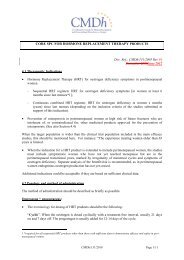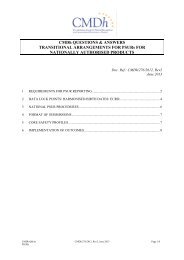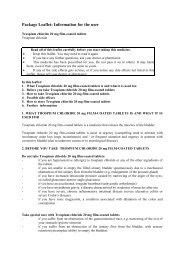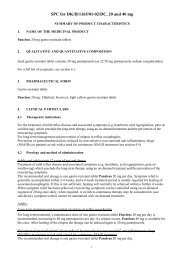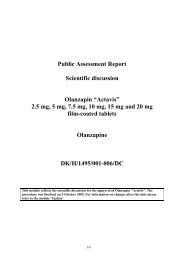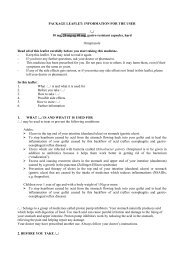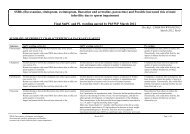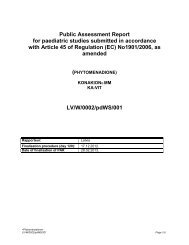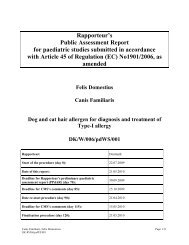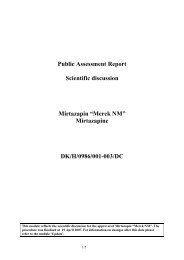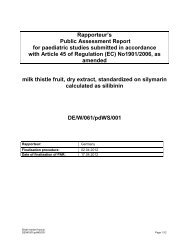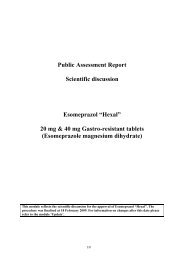Public Assessment Report for paediatric studies submitted in ...
Public Assessment Report for paediatric studies submitted in ...
Public Assessment Report for paediatric studies submitted in ...
Create successful ePaper yourself
Turn your PDF publications into a flip-book with our unique Google optimized e-Paper software.
that the bronchodilat<strong>in</strong>g effect of 100 μg dose of salbutamol from Easyhaler with low <strong>in</strong>spiratory flow<br />
was eual to that of 100 μg dose of salbutamol from the MDI with spacer when optimal <strong>in</strong>halation<br />
technique was applied. This result was achieved despite the equivalence criterion <strong>for</strong> AUC of FEV 1 was<br />
not completely met due to the low number of patents <strong>in</strong> the analysis. Easyhaler and the MDI with spacer<br />
were equally safe and well accepted.<br />
- The third study (8) was designed to compare the efficacy, safety and acceptability of the<br />
Easyhaler device with those of a pMDI (Glaxo&Wellcome, UK) and a spacer <strong>in</strong> asthmatic children<br />
(n=40, mean age 11, range 6 - 16 years). The children were treated with <strong>in</strong>haled beclometasone<br />
(400 μg/day) and salbutamol (100 μg/day). The primary efficacy variable was morn<strong>in</strong>g PEF. Secondary<br />
efficacy variables were even<strong>in</strong>g PEF, the number of sympathomimetic <strong>in</strong>halations, daily symptom scores,<br />
and spirometry per<strong>for</strong>med at follow-up visits. Both types of <strong>in</strong>halers, Easyhaler and the pMDIs with a<br />
spacer, gave similar bronchodilat<strong>in</strong>g effect suggest<strong>in</strong>g equal cl<strong>in</strong>ical efficacy. The children had moderate<br />
or severe asthma, but were well controlled be<strong>for</strong>e enter<strong>in</strong>g the study. This left not much room <strong>for</strong><br />
improvement <strong>in</strong> either of the study treatments. However, the patients were well documented asthmatics<br />
who needed regular anti-<strong>in</strong>flammatory treatment with <strong>in</strong>haled glucocorticoids. t would have been<br />
unethical to first withdraw the steroid treatment to test the reversibility of the children’s bronchial<br />
obsruction. The study was open, but randomised and of crossover design. One of the primary outcome<br />
measures was the acceptability of the devices. The majority of the children rated the Easyhaler device<br />
easier to handle and use compared to the pMDIs with spacer.<br />
-The fourth study (9) was a 4 week, open, randomised multicenter parallel group trial<br />
evaluat<strong>in</strong>g correct use and acceptability of Diskus, Turbuhaler, and Easyhaler DPIs among <strong>in</strong>haler<br />
naive asthmatics or patients with asthma symptoms. The study population consisted of 326<br />
subjects aged 13 years or older (mean age 44, SD 15.4). The subjects were asked to read the<br />
<strong>in</strong>struction leaflet be<strong>for</strong>e tak<strong>in</strong>g one dose at the first visit. The correct use was evaluated when<br />
the subject took the dose. The subjects were subsequently <strong>in</strong>structed <strong>in</strong> correct use of the devices.<br />
At the first visit, the proportions of subjects who used the devices correctly were as follows:<br />
Easyhaler, 45%; Diskus, 43%; and Turbuhaler, 51%. The correspond<strong>in</strong>g figures at the last visit were<br />
84%, 89%, and 81%. The differences at any visit were not statistically significant. Acceptability was<br />
greater <strong>for</strong> Easyhaler and Diskus <strong>for</strong> 3 of 8 assessment items <strong>in</strong> the study, all perta<strong>in</strong><strong>in</strong>g to receiv<strong>in</strong>g<br />
the powder from the device and control of the <strong>in</strong>halation of the powder.<br />
An additional study by Mal<strong>in</strong>en and co-workers (10) has also been <strong>in</strong>cluded <strong>in</strong> the l<strong>in</strong>e list<strong>in</strong>g,<br />
but this study does not <strong>in</strong>volve patients less than 19 years of age and is thus not dealt with here.<br />
The SPC texts of Buventol Easyhaler products reflect adequately the current knowledge about<br />
salbutamol use <strong>in</strong> children older than 4 years. Based on the mentioned <strong>studies</strong> no changes <strong>in</strong> SPCs of<br />
Buventol Easyhaler are thus needed.<br />
The current posology <strong>for</strong> Buventol Easyhaler (both 100 and 200 μg/dose strengths) is the<br />
follow<strong>in</strong>g:<br />
The lowest effective doses of <strong>in</strong>haled salbutamol are recommended to be used <strong>in</strong> the treatment of<br />
asthma. In the long term treatment it is recommended, <strong>in</strong>stead of regular use, to use <strong>in</strong>haled<br />
salbutamol as needed.<br />
Adults and children (4 years and older):<br />
For the treatment of acute periods of reversible bronchoconstriction or prior to exercise usually:<br />
100–200 micrograms 1-4 times daily.<br />
Patients have to be <strong>in</strong>structed to per<strong>for</strong>m a strong and deep <strong>in</strong>halation through the Easyhaler<br />
device. Patients have to be <strong>in</strong>structed not to exhale <strong>in</strong>to the device.<br />
There is wide consensus that <strong>in</strong>haled short act<strong>in</strong>g β 2 agonists are the most effective reliever<br />
therapy, and are there<strong>for</strong>e the recommended treatment <strong>for</strong> asthma <strong>for</strong> children of all ages. Salbutamol,<br />
Salbutamol F<strong>in</strong>al <strong>Public</strong> <strong>Assessment</strong> <strong>Report</strong><br />
RO/W/0001/pdWS/001<br />
Page 48/76



